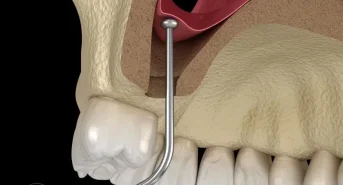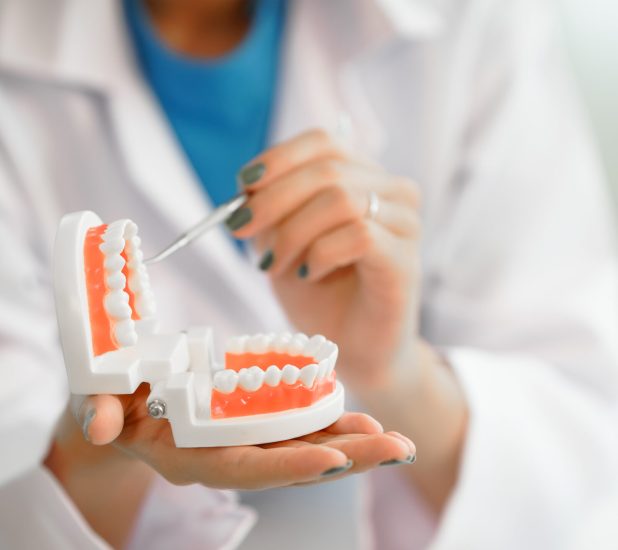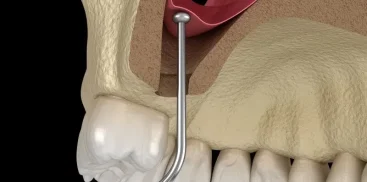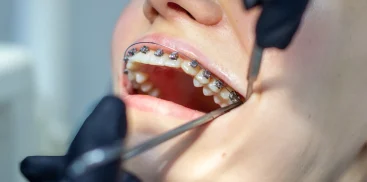What is dental bonding in Warsaw?
Dental bonding is a dental technique that involves bonding the tooth surface with a tooth-colored composite material used to reconstruct teeth after damage or in cases of intense discoloration. The aim of this procedure is to improve the color, shape, and structure of the tooth, allowing for the restoration of teeth aesthetics while maintaining their natural strength. This procedure, part of aesthetic dentistry, is minimally invasive and differs from the use of veneers, which are prefabricated elements requiring only individual adjustment. Dental bonding requires not only precision and manual skills from the dentist but also an artistic sense, which means that the final effect largely depends on the experience of the doctor performing the procedure. At Warsaw Dental Center, our dentists specialize in perfectly performed bonding. It is an effective solution for various dental problems, such as repairing cracked, chipped, discolored, or misshapen teeth, and can also be used to close gaps between teeth or lengthen teeth, allowing for optimal aesthetic results.
Which is better, bonding or porcelain veneers?
The choice between bonding and porcelain veneers depends on several factors, including the specific dental problems you want to address, budget, durability expected from the treatment, and desired aesthetic effects. Ultimately, the best choice depends on specific needs, goals, and professional advice from your dentist. It’s important to have a detailed discussion with your dental care provider to understand the best option for your individual situation. Dentists at Warsaw Dental Center will provide you with all the necessary information needed to make a decision: bonding or veneers?
How long does bonding of a single tooth take in Warsaw?
The process of bonding a single tooth usually takes from 30 to 60 minutes. This time may vary depending on the extent of the repair needed and the specific conditions of the treated tooth. It is a relatively quick and simple procedure, often completed during a single visit to the dentist. At Warsaw Dental Center, during the bonding procedure, our specialists use a microscope. This allows for precise replication of the shape and structure of the treated tooth. In addition, we use materials from reputable manufacturers, ensuring durability and natural color.
How long does bonding last?
The durability of dental bonding can vary significantly depending on factors such as the tooth’s location in the mouth, the extent of bonding, the type of composite material used, and the patient’s hygiene habits, diet, and lifestyle. Generally, dental bonding can last from 3 to 10 years before it needs to be corrected or replaced, which is a relatively easy and quick procedure. It’s worth noting that teeth with bonding may be more prone to discoloration and cracks than natural teeth or other restorative procedures, such as veneers or crowns, so proper care and maintenance are key to extending the lifespan of such a solution. Regular dental check-ups and cleanings, along with good oral hygiene at home, are essential to maintaining the appearance and integrity of bonding.
How many visits are needed for bonding?
Performing dental bonding is usually a simple procedure that in most cases requires only one visit to Warsaw Dental Center. Such a visit typically lasts from 30 minutes to an hour per tooth, depending on the extent of the work needed. The dentist then selects a composite resin that matches the color of your teeth, applies and shapes the material to the desired form, and then hardens it using light. Finally, the bonded area is polished to match the gloss of the rest of the tooth surface. However, in more demanding and extensive restorations, such as a comprehensive aesthetic makeover, it may be necessary to prepare a detailed bonding project that must be accepted by the patient before proceeding with the actual restoration. In such cases, two visits may be needed: one for consultation and planning, and another for the actual bonding procedure.
What are the advantages of dental bonding?
Cost: Bonding is relatively cheaper compared to other restorative procedures.
Duration of the procedure: The bonding procedure usually takes about an hour and does not require impressions or a waiting period for the restoration to be made.
Effectiveness: Bonding offers excellent results that typically last for about a decade.
Aesthetics: The composite resin used mimics the appearance of natural teeth, allowing for beautiful and naturally looking results.
Minimal recovery time: Bonding usually does not require anesthesia, and the procedure requires little or no recovery time.
Improvement of oral health: Cracked or damaged teeth can be further damaged. Bonding provides a protective layer for the damaged surface.
What are the disadvantages of bonding?
Not for serious dental problems: Bonding is effective only in specific cases. Significant damage or decay may require more advanced interventions, such as crowns, veneers, bridges, or implants.
Limited results: The material used for bonding is not as durable as a crown. It may crack over time. It’s important to avoid biting hard objects or foods. Composite materials also undergo wear, which is a natural phenomenon.
Susceptibility to discoloration: Bonding is not as resistant to stains as porcelain restorations, such as veneers or crowns.
Gum disease and periodontitis: Before proceeding with bonding, these conditions must be treated.
Bite problems: Bonding is not a method for treating bite problems; it may be advisable to wear braces before bonding to prolong its durability.
Bruxism: In people who grind and clench their teeth at night, bonding may prove to be impermanent and prone to cracks and damage. Therefore, it is recommended for these individuals to first undergo physiotherapy and then use a night guard.
What are the contraindications for dental bonding?
Contraindications for dental bonding include:
1. Advanced decay or damage to the tooth: Bonding may not be suitable for teeth that are heavily damaged by decay or have significant structural damage. In such cases, more advanced restorative procedures, such as crowns or implants, may be necessary.
2. Poor oral hygiene: Patients with poor oral hygiene may not be ideal candidates for bonding, as the longevity of the bonding material may be compromised by factors such as plaque buildup and periodontal diseases.
3. Bruxism: Individuals with a strong bite or suffering from bruxism (teeth grinding) may not be suitable candidates for bonding, as the pressure can cause the bonding material to crack or break.
4. Large fillings or extensive repairs: Teeth requiring large fillings or extensive repairs may not be suitable for bonding, as the composite material may not provide sufficient strength for large reconstructions.
5. High aesthetic expectations: For patients seeking the perfect aesthetic effect, especially for front teeth, veneers or crowns may be a better solution, as they can offer a more durable and aesthetically pleasing solution compared to bonding.
6. Allergy to composite resin: Although rare, some individuals may be allergic to materials used in composite resin. In such cases, alternative treatment should be considered.
7. Gum disease and periodontitis: Bonding should not be performed on teeth affected by active periodontal disease until the disease is cured and the gums are healthy.
How much does bonding cost?
The price for bonding a single tooth at Warsaw Dental Center is 1000 PLN. This reflects the extensive experience of our specialists in performing such procedures, the use of a microscope for more accurate replication of the tooth structure, and the use of advanced materials from reputable manufacturers, allowing for faithful reconstruction of tooth tissues.
What to avoid after dental bonding?
Care for teeth after bonding treatment includes both immediate post-treatment care and long-term maintenance to ensure the durability and appearance of the bonding material. Here are some tips:
Immediate post-treatment care (first few days to a week)
– Avoid staining products: After bonding treatment, it’s important to avoid dark beverages, such as coffee, tea, and red wine, and foods that can cause staining, for the first 48 hours to prevent discoloration of the material.
– Caution with hard and sticky foods: Products that are particularly hard, chewy, or sticky can potentially damage the bonding material. It is recommended to avoid hard candies, ice, and other similar items, especially right after the procedure.
Long-term care:
– Oral hygiene: Maintain good oral hygiene by brushing your teeth twice a day with fluoride toothpaste and flossing at least once a day. This helps prevent decay around bonded areas and maintains overall oral hygiene.
– Regular dental visits: Plan regular check-ups and cleanings, usually every six months, to ensure the longevity of dental bonding and maintain oral health. Your dentist can check the condition of the material and address any issues before they become serious.
– Avoid harmful habits: Try to avoid habits that can damage teeth and bonding, such as biting nails, chewing pens, or using teeth to open packages.
– Protect your teeth: If you participate in sports or activities that can potentially damage teeth, consider wearing a mouthguard to protect bonded teeth from injury.
Can bonding be done on a single tooth?
Yes, bonding can be performed on just one tooth. Dental bonding is a versatile aesthetic dentistry procedure that can be applied to a single tooth or multiple teeth, depending on the patient’s needs. It is commonly used to repair a cracked, chipped, or discolored tooth, close gaps between teeth, lengthen a tooth, or change the shape of a tooth. If you have a specific problem with one tooth that you want to address for aesthetic or functional reasons, bonding can be an effective and minimally invasive option.
What affects the outcome of bonding?
Several factors can influence the outcome and durability of dental bonding, including:
1. Quality of the material: The type of composite resin used can affect the appearance and durability of the bonding. Higher quality materials may offer better color matching and durability.
2. Skills and experience of the dentist: The dentist’s experience in performing bonding procedures can significantly influence the final result. Precision in the application and shaping of the composite resin is key to a natural and attractive appearance.
3. Location of the tooth: Teeth that are more exposed to stress from biting and chewing, such as molars, may wear
down bonding materials faster or be more prone to damage than less burdened teeth, such as front incisors.
4. Habits: Habits such as nail biting, chewing pens, teeth grinding (bruxism), or consuming hard foods can compromise the integrity of the composite material, leading to chips or detachment.
5. Oral hygiene and care: Proper hygiene practices, including regular brushing and flossing, help maintain the bonding material. Avoiding substances that cause discoloration, such as coffee, tea, and tobacco, can also preserve the color.
6. Regular dental check-ups: Regular visits to the dentist for check-ups and cleaning can help maintain the health and appearance of bonded teeth.
7. Overall oral health of the patient: The presence of issues such as tooth decay or gum diseases can affect the bonding process and its durability. Healthy teeth and gums provide a better foundation for bonding.
We invite you to Warsaw Dental Center, where our specialists have extensive experience in performing bonding. They will help you achieve durable and beautiful results and teach you how to care for your teeth so you can enjoy a beautiful smile throughout the year.
Article written on 15.08.2022 and updated on 26.02.2024 based on the latest technology and research.










